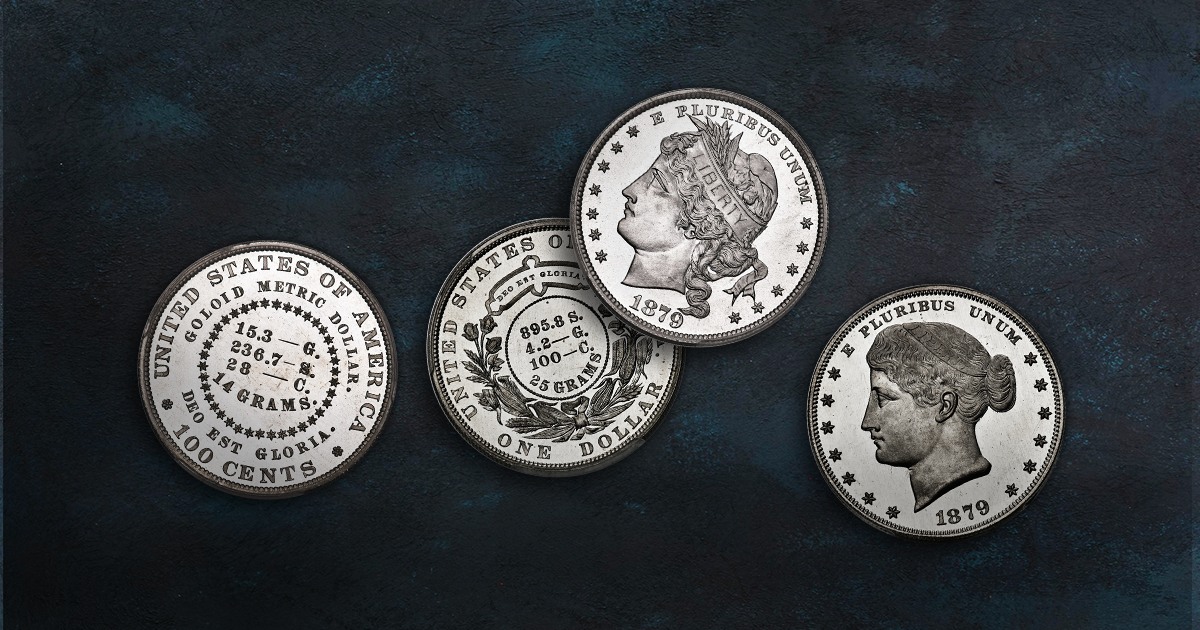
The Goloid Metric Pattern was a unique and ultimately unsuccessful experimental pattern series in United States coinage. In the late 19th century, during debates over the gold standard and monetary reform, this unconventional composition and system aimed to ease international trade and solve domestic financial challenges.
Origins and Context of the Goloid Metric Pattern
In the aftermath of the American Civil War, the U.S. faced significant monetary issues. The discovery of large gold reserves in California disrupted the balance between gold and silver, which led to much of the United States population hoarding silver coins and making it difficult to stabilize the currency. To resolve this, Dr. William Wheeler Hubbell proposed an innovative solution: goloid, a new alloy composed of silver, gold, and copper, aimed at stabilizing the value of currency while facilitating international trade.
Dr. Hubbell patented the goloid alloy in 1877. It contained 90.3% silver, 0.3% gold, and 9.4% copper, with the aim of creating coins with equal monetary values of silver and gold that were distinguishable from standard coinage metals. His secondary goal was to introduce a metric coinage system that would align U.S. coinage with international standards, making it easier to conduct global trade.
Dr. William Wheeler Hubbell and His Congressional Proposal
Dr. Hubbell’s motivation to stabilize currency and facilitate trade led him to propose his Goloid Metric Dollar to Congress. His alloy offered a potential solution to the economic instability caused by the Coinage Act of 1873. This act had demonetized silver, causing a public outcry, especially among advocates of bimetallism. Hubbell’s innovative alloy gained the support of Mint Director Henry Linderman, who facilitated the production of pattern coins to present to Congress. However, despite initial interest, the proposal was met with skepticism due to concerns about practicality and counterfeiting.
The 1878 Goloid Metric Pattern and Subsequent Patterns
The U.S. Mint produced several goloid patterns between 1878 and 1880. The coins featured detailed inscriptions, including their composition and metric weight. For example, the 1879 Goloid Metric Dollar prominently displayed its proportions of gold, silver, and copper, as well as its total weight in grams.
| Year | Coin Type | Description | Notable Features |
| 1878 | Goloid Metric Dollar | Liberty’s bust, metric inscriptions | Metric weight and composition on reverse |
| 1879 | Stella (Four-Dollar Coin) | Part of metric series, not goloid | Aimed at international trade |
| 1879 | Goloid Metric Dollar | George Morgan designed Coiled Hair | Metric weight and composition on reverse |
| 1880 | Goloid Metric Dollar | Continued series | Slight design modifications from earlier years |
The Composition of Goloid Coins
The first goloid coins were minted in 1878, using the patented composition, though it varied slightly across different batches. Below is a breakdown of the goloid coins’ composition:
| Year | Composition | Weight | Gold Content | Silver Content | Copper Content |
| 1878 | Goloid | 14.25 g | 0.3% | 90.3% | 9.4% |
| 1879 | Goloid | Varies | Slightly less | More silver | 10% |
| 1879 | Gold | 7 g | 86% | 4% | 10% |
| 1880 | Goloid | Varies | Less than 1879 | More silver | 10% |
Challenges in Production and Recognition
Although the concept of goloid coins was innovative, several significant challenges hindered its success. The most critical issue was difficulty distinguishing goloid coins from standard silver coins. Without metallurgical testing, the alloy was nearly indistinguishable. This made the coins vulnerable to counterfeiting. This problem earned the coins the nickname “Counterfeiter’s Delight,” further undermining their potential for widespread adoption.
Legislative and Public Response
While Hubbell’s proposal received support from some quarters, skepticism persisted. Congressional hearings were held to evaluate the practicality of the goloid coins, during which Mint Director Henry Linderman famously demonstrated how difficult it was to tell goloid coins apart from silver coins. The public also expressed mixed feelings, with some newspapers criticizing the concept of goloid as unnecessary and impractical. In response to these challenges, Congress ultimately rejected the bill to introduce goloid coins into circulation.
| Event | Year | Outcome | Notes |
| Introduction of Goloid in Congress | 1877 | Bill introduced, not passed | Concerns over counterfeiting and practicality |
| Public Opinion | 1878 | Mixed reactions | Some saw potential, others skeptical |
| Congressional Hearings | 1878 | Demonstration of alloy’s issues | Led to further doubts about goloid’s feasibility |
Why was the Goloid Pattern Metric?
Metric Coins in Europe
In Europe, the metric system was introduced in France in 1799 and gradually adopted by other nations during the 19th century. However, its use in coinage was inconsistent across the continent. While countries like France standardized coinage based on the metric system, others retained traditional methods for measuring coins, leading to a mix of systems. Dr. Hubbell’s proposal to adopt metric standards in U.S. coinage was a forward-thinking attempt to align with this growing international trend, positioning the U.S. as a modern participant in global trade.
The Influence of Ancient Coinage
Interestingly, goloid was not the first attempt to combine gold and silver in a single coin. The alloy electrum was used in ancient Lydia in the 7th century BCE and combined both metals to create some of the earliest known coinage. This parallel highlights the long-standing challenges of creating stable, multi-metal currencies. Goloid, like electrum, faced difficulties distinguishing itself from other coinage materials, particularly silver.
Discontinuation and Legacy of Goloid Metric Patterns
Despite the short-lived production of goloid coins, their legacy endures in numismatic circles. Today, goloid metric patterns are highly sought after by collectors due to their rarity and the unique insight they offer into a transitional period in U.S. monetary history. Their failure highlights the complexities of monetary reform and the challenges of introducing new alloys in coinage.




